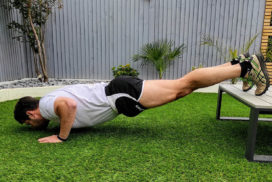Cardio and fat loss both play important roles in bodybuilding.
In order to sculpt a proportional and chiseled physique, you need to keep your levels of body fat to a minimum.
Without low body fat levels, your muscles will not be as defined and you will lose athleticism, have lower testosterone, have lower energy levels, and more. To keep body fat low, there are three main ways to achieve this goal.
The first way to keep your body fat levels low is to eat less. When you decrease your caloric intake, your body will begin to use other sources of energy, such as fat, in order to complete it’s normal functions throughout the day. As long as you continue to workout and do resistance training, by decreasing your caloric intake you can promote fat loss and hold on to the muscle you currently have.
A second way to reduce your levels of body fat is to increase your activity level. Walking instead of driving, taking the stairs instead of the escalator, working at a standing desk, and doing other small lifestyle changes can all add up to increase the amount of calories you burn every day. By increasing your daily activity, you will make your body draw more energy from other sources such as food, fat, and muscle.
If you keep your caloric intake the same and workout regularly, your body will burn fat.
A final way to lower your levels of body fat is to do cardio.
Two of the simplest and most efficient forms of cardio are running and sprinting.
The Benefits of Sprinting For Bodybuilding
Between running and sprinting, the best form of cardio to do is sprinting.
Sprinting is great for bodybuilding for a variety of reasons. These are the main benefits of sprinting within the context bodybuilding:
- Sprinting improves circulation
- Sprinting burns calories efficiently
- Sprinting builds the quadriceps, calves, and hamstrings
- Sprinting elevates testosterone and growth hormone
- Sprinting promotes fat oxidation
- Sprinting elevates protein synthesis
- Sprinting helps overall heart health
- Sprinting improves the delivery of oxygen to the muscles
Does Sprinting Burn More Calories Than Running?
Sprinting burns calories faster than running.
Sprinting is able to burn calories quicker than running because sprinting increases your heart rate more drastically and recruits more muscles.
The rate at which cardio burns calories depends on how fast your heat rate is elevated, how much stress is put on your body, and how high your heart rate goes.
When running, your heart rate gradually increases and stays slightly elevated. During sprints, your heart rate quickly goes from resting to highly elevated and your body is suddenly put under a significant amount of stress.
Running also causes higher amounts of cortisol to be released in response to exercise which can cause more muscle mass to be lost compared to anaerobic training like sprinting.
How Many Calories Does Sprinting Burn?
Sprinting burns around 1,000 calories per hour.
This study on 5 college males found that doing sprints for 2.5 minutes burns over 200 calories.
If you do an intense sprint session once every 10 minutes for an hour, you will burn at least 1,000 calories.
After sprinting, the overall rate at which you burn calories is also elevated for the rest of the day. This means that sprinting not only burns calories very quickly, but also helps you burn calories after you’re done exercising.
How Many Calories Does Running Burn?
Running burns around 400-600 calories per hour if you run without stopping.
On average, about 100 calories are burned per mile ran.
This study found that, for the average person, jogging burns 240 calories per hour and running burns almost 600 calories per hour if done at a pace of 5 miles per hour.
Does Running Cause Muscle Loss?
One of the largest concerns of bodybuilders and weightlifters about doing cardio is the risk of muscle loss.
Doing cardio can cause muscle loss by putting you in too large of an energy deficit and elevating catabolic hormones.
If you burn off more than 1,000-2,000 calories in a few hours, the body will often be forced to use muscle mass as a source of energy once it runs out of food and can’t utilize fat quickly enough.
If you regularly do cardio, over time your body will strip away the muscle you don’t need to make doing the cardio easier. Weightlifting tells your body to become stronger and cardio tells your body to become lighter and more efficient.
It is possible to balance weightlifting and cardio, however when you tip the scale too far in one direction, you will lose progress on the opposite end of the spectrum.
If you make sure to eat enough and do anaerobic cardio (sprinting, boxing, circuit training) then the impact of running or doing sprints on muscle loss will be minimal.
Running does cause more cortisol to be released than sprinting, so if you have the option, sprints are much better to ensure you hold on to your muscle and still receive the benefits of doing cardio.
Summary
In summary, sprinting is better than running for bodybuilding.
Sprinting is better than running because it increases anabolic hormones, builds muscles in the legs, burns calories quicker, doesn’t wear down your joints, causes less catabolic hormones to be released, elevates protein synthesis, and can improve heart health.
Sprinting in intervals burns around 1,000 calories per hour and running burns around 400-600 calories per hour if you run for the duration of the hour. Bodybuilders should use sprinting as the primary method to lose fat.
For more on training and cardio, such as the best way to quickly progress in pull-ups and how to get visible abs, click here.







